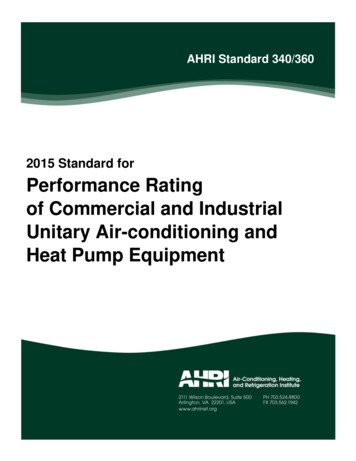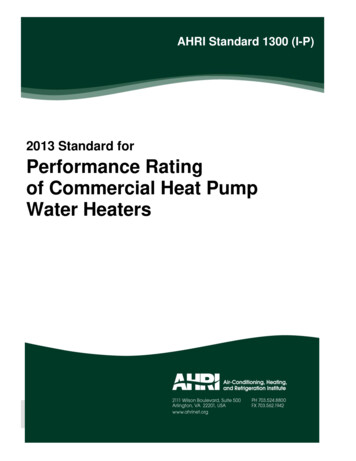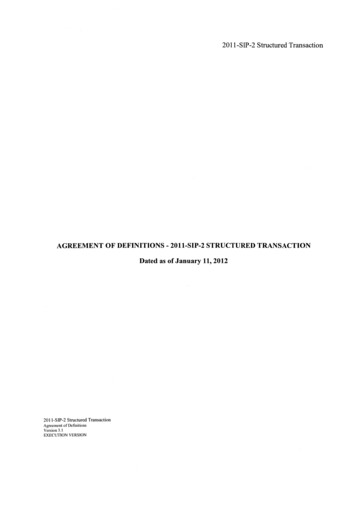
Transcription
AHRI Standard 340/3602015 Standard forPerformance Ratingof Commercial and IndustrialUnitary Air-conditioning andHeat Pump EquipmentPrice 10.00 (M) 20.00 (NM)Printed in U.S.A. Copyright 2015, by Air-Conditioning, Heating, and Refrigeration InstituteRegistered United States Patent and Trademark Office
IMPORTANTSAFETY DISCLAIMERAHRI does not set safety standards and does not certify or guarantee the safety of any products, components orsystems designed, tested, rated, installed or operated in accordance with this standard/guideline. It is stronglyrecommended that products be designed, constructed, assembled, installed and operated in accordance withnationally recognized safety standards and code requirements appropriate for products covered by thisstandard/guideline.AHRI uses its best efforts to develop standards/guidelines employing state-of-the-art and accepted industrypractices. AHRI does not certify or guarantee that any test conducted under its standards/guidelines will be nonhazardous or free from risk.Note:This 2015 standard supersedes ANSI/AHRI Standard 340/360-2007 with Addendum 1 and 2.AHRI CERTIFICATION PROGRAM PROVISIONSScope of the Certification ProgramThe Certification Program applies to 50 Hz and 60 Hz equipment including: Unitary Air-conditioners and Heat Pumps from 65,000 Btu/h to less than 250,000 Btu/h;oSingle Packaged and Split SystemsoAir-cooled and water-cooledAir-cooled Air-conditioning Condensing Units from 135,000 Btu/h to less than 250,000 Btu/h(covered by AHRI Standard 365);Air-cooled Single Packaged Unitary Air-conditioners from 250,000 Btu/h to less than 760,000 Btu/h.Products sold in the intended market of the US and Canada must comply with the “certify all requirements”. For 60Hz and 50 Hz products sold outside the intended market of the US and Canada, certification is optional. If theparticipant does not wish to carry certification of a model sold for use outside the intended market, this product shallcarry a separate and unique model number from an existing AHRI certified model number to avoid market confusion.Certified RatingsThe following certified ratings are verified by test:Unitary Air-conditionersAir-cooled, water-cooled and evaporatively-cooled from 65,000 Btu/h to below 250,000 Btu/h.1.2.3.Cooling Capacity, Btu/h at Standard Rating ConditionsEnergy Efficiency Ratio, EER, Btu/W·h at Standard Rating ConditionsIntegrated Energy Efficiency Ratio, (IEER), Btu/W·h at Standard Rating ConditionsUnitary Air-Cooled Packaged Air-Conditioners from 250,000 Btu/h to less than 760,000 Btu/h.1.2.3.Cooling Capacity, Btu/h at Standard Rating ConditionsEnergy Efficiency Ratio, EER, Btu/W·h at Standard Rating ConditionsIntegrated Energy Efficiency Ratio, (IEER), Btu/W·h at Standard Rating ConditionsAir-source Unitary Heat Pump Equipment
Air-cooled from 65,000 Btu/h to below 250,000 Btu/h.1. Cooling Capacity, Btu/h at Standard Rating Conditions2. Energy Efficiency Ratio, EER, Btu/W·h at Standard Rating Conditions3. Integrated Energy Efficiency Ratio, IEER, Btu/W·h at Standard Rating Conditions4. High Temperature Heating Standard Rating Capacity, Btu/h at 47 F5. High Temperature Coefficient of Performance, COPH, W/W, at 47 F6. Low Temperature Heating Standard Rating Capacity, Btu/h, at 17 F7. Low Temperature Coefficient of Performance, COPH, W/W, at 17 FConformance to the requirements of the maximum operating condition test, cooling low temperature operation test,insulation efficiency test (cooling), and condensate disposal test (cooling) are also verified initially by test formanufacturers applying into the AHRI ULE Certification Program.Foreword:AHRI Standard 340/360 – 2015 contains many significant revisions to the 2007 .18.The revised standard includes definition and test requirements for Double-duct commercial unitaryequipment.Definitions have been expanded and clarified including an updated definition for IEER.Table 1, Classification of Commercial and Industrial Unitary Air-Conditioner Equipment has been rewrittenfor clarity.Table 2, Classification of Commercial and Industrial Unitary Heat Pump Equipment has been rewritten forclarity.The part load efficiency, IEER, test method is simplified by eliminating the iterative OD test conditionsneeded to achieve a desired load point. The new method requires an additional test point at known conditionsto be run in order to interpolate to the desired load point. This simplifies the test procedure (Table 6). Thismethod also reduces the uncertainty with the addition of a 3% tolerance for part load percent.Section 5, Test Requirements, has been expanded to cover items not documented in ASHRAE Standard 37.The standard adds a tolerance of 3% on required part load Percent Load point where interpolation anddegradation is not required (Table 7).The revised standard includes optional International Rating Conditions (Section 6.3) relevant to internationalrequirements that may be used optionally. The Rating Conditions are intended to align with ISO 5151, 13253and 15042 conditions.The standard includes a step by step procedure to generate IEER ratings based on either test method orcomputer simulation. This also includes clarification on procedures for fixed, capacity, staged capacity andvariable capacity units (Section 6.4).Verification test uncertainty allowances have been explained and clarified for the performance metrics in thestandard. (Section 6.5 & Section 6.6).Documentation of the confidence level has been added at 90% for EER, IEER and COP.Tolerances have been added for airflow at 3%.Appendix D, Atmospheric Pressure Correction, has been added to the standard, which prescribes acomputational method to correct measured product performance for air density variations resulting fromatmospheric pressure changes due to weather conditions and altitude. Revisions were made throughout thestandard to reflect the atmospheric pressure corrections.Appendix E. Unit Configuration for Standard Efficiency Determination, has also been added to the standard,which prescribes the requirements for the configuration of a unit that is used for determining the StandardRating Cooling and Heating Capacity and efficiency metrics. Appendix E documents DOE certificationrequirements agreed to with the development of the AEDM procedure.The revised standard tightens the tolerances on external static pressure and airflow. (Appendix F, Section F4& F5).Appendix G, Examples of IEER Calculations, provides a comprehensive set of IEER calculation examplescovering many potential product configurations.References have been updated to reflect the latest available standards.Appendix F, Method of Testing Unitary Air Conditioning Products, has been updated to reflect testprocedures not defined by ASHRAE 37-2009.
TABLE OF CONTENTSSECTIONPageSection 1.Purpose . 1Section 2.Scope . 1Section 3.Definitions. 2Section 4.Classifications . 4Section 5.Test Requirements. 6Section 6.Rating Requirements . 7Section 7.Minimum Data Requirements for Published Ratings .20Section 8.Operating Requirements. 21Section 9.Marking and Nameplate Data . 23Section 10.Conformance Conditions . 23TABLESTable 1.Classification of Commercial and Industrial Unitary Air-conditioningEquipment . 5Table 2.Classification of Commercial and Industrial Unitary Heat Pump Equipment. 6Table 3.Conditions for Standard Rating and Operating Tests . 9Table 4.External Static Pressure.11Table 5.Section References for Different Product Classifications .13Table 6.IEER Part Load Rating Conditions .13Table 7.Tolerance on Part Load Percent Load .16Table 8.International Standard Rating Conditions .19Table 9.Uncertainty Allowances .20FIGURESFigure 1.Example Revised Part Load Ambient Conditions for Interpolation .14
TABLE OF CONTENTS (continued)APPENDICESAppendix A.References - Normative.24Appendix B.References - Informative .25Appendix C.Condenser Entering Air Temperature Measurement – Normative .26Appendix D.Atmospheric Pressure Correction – Normative .32Appendix E.Unit Configuration for Standard Efficiency Determination – Informative .35Appendix F.Method of Testing Unitary Air Conditioning Products – Normative .38Appendix G.Examples of IEER Calculations - Informative .40TABLES FOR APPENDICESTable C1.Temperature Measurement Requirements.26Table C2.Criteria for Air Distribution and Control of Air Temperature.27Table G1.Table of Contents of Examples .40Table G2A.Example 1 Test Results with Adjustment for Atmospheric Pressure .41Table G2B.Example 1 IEER Rating Points and Degradation Calculations .42Table G3A.Example 2 Test Results with Adjustment for Atmospheric Pressure .43Table G3B.Example 2 IEER Degradation Calculations .44Table G4A.Example 3 Test Results with Adjustment for Atmospheric Pressure .45Table G4B.Example 3 Degradation Calculations .46Table G5A.Example 4 Test Results with Adjustment for Atmospheric Pressure .47Table G5B.Example 4 IEER Rating Points and Degradation Calculations .48Table G6A.Example 5 Test Results with Adjustment for Atmospheric Pressure .50Table G6B.Example 5 IEER Rating Points and Degradation Calculations .51Table G7A.Example 6 Test Results with Adjustment for Atmospheric Pressure .52Table G7B.Example 6 IEER Rating Points and Degradation Calculations .53Table G8A.Example 7 Test Results with Adjustment for Atmospheric Pressure .54Table G8B.Example 7 IEER Rating Points and Degradation Calculations .55Table G9A.Example 8 Test Results with Adjustment for Atmospheric Pressure .57Table G9B.Example 8 IEER Rating Points and Degradation Calculations .58
TABLE OF CONTENTS (continued)Table G10A.Example 9 Test Results with Adjustment for Atmospheric Pressure .59Table G10B.Example 9 IEER Rating Points and Degradation Calculations .60Table G11A.Example 10 Test Results with Adjustment for Atmospheric Pressure .61Table G11B.Example 10 IEER Rating Points and Degradation Calculations .62FIGURES FOR APPENDICESFigure C1.Typical Air Sampling Tree .28Figure C2.Aspirating Psychrometer .29Figure C3.Determination of Measurement Rectangles and Required Number of Air Sampler Trees .30Figure C4.Typical Test Setup Configurations .31Figure G1.Example 4 Test Points Used for EER Rating Points .48
AHRI STANDARD 340/360-2015PERFORMANCE RATING OF COMMERCIAL ANDINDUSTRIAL UNITARY AIR-CONDITIONING AND HEATPUMP EQUIPMENTSection 1. Purpose1.1Purpose. The purpose of this standard is to establish for Commercial and Industrial Unitary Air-conditioning andHeat Pump Equipment: definitions; classifications; test requirements; rating requirements; minimum data requirements forPublished Ratings; operating requirements; marking and nameplate data; and conformance conditions.1.1.1 Intent. This standard is intended for the guidance of the industry, including manufacturers, engineers,installers, contractors, federal and state regulations, and efficiency standards developed by American Society ofHeating, Refrigerating, and Air-Conditioning Engineers (ASHRAE), International Energy Conservation Code(IECC), Canadian Standards Association (CSA), Department of Energy (DOE), and users.1.1.2 Review and Amendment. This standard is subject to review and amendment as technology advances.Section 2. Scope2.1Scope. This standard applies to factory-made Commercial and Industrial Unitary Air-conditioning and Heat PumpEquipment as defined in Section 3.2.1.1 Energy Source. This standard applies only to electrically operated, vapor compression refrigeration systems.2.2Exclusions. This standard does not apply to the following:2.2.1 Rating and testing of individual assemblies, such as condensing units or coils, for separate use.2.2.2 Unitary Air-conditioners and Unitary Heat Pumps as defined in ANSI/AHRI Standard 210/240, withcapacities less than 65,000 Btu/h.2.2.3 Water-Source Heat Pumps as defined in ISO/ANSI/AHRI/ASHRAE 13256-1.2.2.4 Variable Refrigerant Flow Air Conditioners and Heat Pumps as defined in ANSI/AHRI Standard 1230.2.2.5 Rating of units equipped with desuperheater/water heating devices (as defined in ANSI/AHRI Standard 470)in operation.2.2.6 Commercial and Industrial Condensing Units with a capacity greater than 135,000 Btu/h as defined inANSI/AHRI Standard 365 (I-P), Performance Rating of Commercial and Industrial Unitary Air-conditioningCondensing Units.2.3Other Applicable Standards. Commercial and Industrial Unitary Air-conditioning and Heat Pump Equipment mayalso be rated using the following standards:2.3.1 Single vertical packaged air conditioners rated using ANSI/AHRI Standard 390.2.3.2 Dedicated outdoor air systems rated using ANSI/AHRI Standard 920 (I-P).2.3.3 Air conditioners and condensing units serving computer rooms rated using ANSI/AHRI Standard 1360.2.3.4 Commercial and industrial unitary air-conditioning condensing units rated using ANSI/AHRI Standard 365(I-P).1
AHRI STANDARD 340/360-2015Section 3. DefinitionsAll terms in this document shall follow the standard industry definitions in the ASHRAE Terminology ions/free-resources/ashrae-terminology), unless otherwise defined in this section.3.1Basic Model. All systems within a single equipment class and which have the same or comparably performingcompressor(s), condensing coil(s), evaporator coil(s), and air moving system(s) that have a common “nominal” CoolingCapacity.Note:See 10 CFR §429 for DOE definition.3.2Commercial and Industrial Unitary Air-conditioner. One or more factory-made assemblies, which normally includea cooling coil, an air moving device, a compressor(s) and condenser combination, and may include a heating function as well.Where such equipment is provided in more than one assembly, the separate assemblies shall be designed to be used together,and the requirements of rating outlined in this standard shall be based upon the use of matched assemblies. The functions ofCommercial and Industrial Unitary Air-conditioners, either alone or in combination with a heating plant, are to provide aircirculation, cooling, dehumidification, and may include the Functions of heating, humidifying, outdoor air ventilation, and aircleaning.3.3Commercial and Industrial Unitary Heat Pump. One or more factory-made assemblies, which normally include anindoor conditioning coil, an air moving device, compressor(s), and an outdoor coil(s), including means to provide a heatingfunction and may or may not include a cooling function. When such equipment is provided in more than one assembly, theseparate assemblies shall be designed to be used together, and the requirements of rating outlined in the standard shall bebased upon the use of matched assemblies. Commercial and Industrial Unitary Heat Pumps shall provide the function ofheating and may include the function of air circulation, air cooling, dehumidifying or humidifying, outdoor air ventilation,and air cleaning.3.4Cooling Capacity. The net capacity associated with the change in air enthalpy between the air entering the unit andthe air leaving the unit, which includes both the Latent and Sensible Capacities expressed in Btu/h and includes the heat ofcirculation fan(s) and motor(s).3.4.1 Standard Cooling Capacity. Full load Cooling Capacity at Standard Rating Conditions for a unit configuredin accordance with Appendix E, and when tested in accordance with the requirements of Appendix F.3.4.2Latent Capacity. Capacity associated with a change in humidity ratio, expressed in Btu/h.3.4.3Sensible Capacity. Capacity associated with a change in dry-bulb temperature, expressed in Btu/h.3.5Double-duct System. Double-duct air conditioner or heat pump means air-cooled commercial package airconditioning and heating equipment that is either a horizontal single package or split-system unit; or a vertical unit that consistsof two components that may be shipped or installed either connected or split; is intended for indoor installation with ductingof outdoor air from the building exterior to and from the unit, where the unit and/or all of its components are non-weatherizedand are not marked (or listed) as being in compliance with UL 1995/CSA C22.2 No.236 or equivalent requirements for outdooruse. If it is a horizontal unit, the complete unit shall have a maximum height of 35 inches or the unit shall have componentsthat do not exceed a maximum height of 35 inches. If it is a vertical unit, the complete (split, connected, or assembled) unitshall have components that do not exceed maximum depth of 35 inches; and, a rated Cooling Capacity greater than and equalto 65,000 Btu/h and less than or equal to 300,000 Btu/h.3.6Energy Efficiency Ratio (EER). A ratio of the Cooling Capacity in Btu/h to the power input values in watts at anygiven set of Rating Conditions expressed in Btu/W·h.3.6.1 Standard Energy Efficiency Ratio (EER). A ratio of the Cooling Capacity in Btu/h to the total operating powerinput in watts at Standard Rating Conditions expressed in Btu/W·h for a unit configured in accordance withAppendix E, and when tested in accordance with the requirements of Appendix F.3.72Fixed Capacity Controlled Units. Products limited by the controls to a single stage of refrigeration capacity.
AHRI STANDARD 340/360-20153.8Full Load Rated Indoor Airflow. The Standard Airflow rate at 100% capacity as defined by the manufacturer and atthe external static pressure as listed in Table 5. The airflow shall be expressed as Standard Air with a density of 0.075 lb/ft3.3.9Heating Capacity. The capacity associated with the change in dry-bulb temperature expressed in Btu/h.3.10Heating Coefficient of Performance (COPH). A ratio of the Heating Capacity in watts to the power input values inwatts at any given set of Rating Conditions expressed in W/W. For heating COP, supplementary resistance heat shall beexcluded.3.11Integrated Energy Efficiency Ratio (IEER). A weighted calculation of mechanical cooling efficiencies at full loadand part load Standard Rating Conditions, defined in Section 6.2, expressed in Btu/W·h.3.12Indoor Package Air-conditioners. Units with factory-made assemblies of one or more evaporator fans, evaporatorcoils, and condensing units having means for air cooling, cleaning, dehumidification, heating with factory or field installedelectric strip heaters and forced air circulation through a duct system and which may also have means for humidifying andcontrol of temperature. These units do not have gas heat and are not heat pumps. Included are only those units that areassembled or designed to be assembled in a single unit (within a single factory made enclosure).3.13Multi Zone Variable Air Volume (MZVAV). Units with control systems designed to vary the indoor air volume andrefrigeration capacity/staging at a controlled discharge air temperature and static pressure as a means of providing spacetemperature control to independent multiple spaces with independent thermostats.3.14Package Air-conditioners. Units with factory-made assemblies of one or more evaporator fans, evaporator coils, andcondensing units having means for air cooling, cleaning, dehumidification, heating with factory or field installed electric stripheaters and forced air circulation through a duct system and which may also have means for humidifying and control oftemperature. These units do not have gas heat and are not heat pumps. Included are only those units that are assembled ordesigned to be assembled in a single unit (within a single factory made enclosure). Single package (cooling only) roof topunits are included in this category.3.15Package Heat Pumps. Units that can both cool and heat with the refrigeration system which may have provision forelectric, hot water, steam or gas heat (dual fuel) that are factory-made assemblies of one or more evaporator fans, evaporatorcoils, and condensing units having means for air cooling, heating, cleaning, dehumidification, and forced air circulationthrough a duct system and which may also have means for humidifying and control of temperature, with provision formodifying the performance so that either heating or cooling and dehumidification may be produced. Included are only thoseunits that are assembled or designed to be assembled in a single unit (within a single factory made enclosure).3.16Package Year Round Air-conditioners. Gas and oil Package Air-Conditioners which are factory-made assemblies ofone or more evaporator fans, evaporator coils, and condensing units and equipped with gas or oil fired heating sections andmeans for air cooling, cleaning, dehumidification, heating and forced air circulation through a duct system and which mayalso have means for humidifying and control of temperature. Included are only those units that are assembled or designed tobe assembled in a single unit (within a single factory made enclosure).3.17Part Load Rated Indoor Airflow. The Standard Airflow at the part load ratings conditions as defined by themanufacturer and at the external static pressure as listed in Table 5 with modifications shown in Table 6. This may be differentfor each part load rating point. The airflow is expressed as Standard Air, expressed in units of ft3/min.3.18Percent Load. The ratio of the part load Cooling Capacity over the measured full load Cooling Capacity at StandardRating Conditions, expressed as a decimal.3.19Proportionally Controlled Units. Units incorporating one or more variable capacity compressors in which thecompressor capacity can be modulated continuously or in steps not more than 5% of the AHRI Standard 540, Table 2, ratingtest point A capacity (45/130/20/15). The modulating compressor or compressors shall be capable of modulating the unitcapacity over a range of at least 50% to 100%. The unit may also include combination of fixed capacity and variable capacitycompressors.3.20Published Rating. A statement of the assigned values of those performance characteristics, under stated RatingConditions, by which a unit may be chosen to fit its application. These values apply to all units of like nominal size and type(identification) produced by the same manufacturer. As used herein, the term Published Rating includes the rating of all3
AHRI STANDARD 340/360-2015performance characteristics shown on the unit or published in specifications, advertising or other literature controlled by themanufacturer, at stated Rating Conditions.3.20.1 Application Rating. A rating based on tests performed at Application Rating Conditions (other than StandardRating Conditions).3.20.2 Standard Rating. A rating based on tests performed at Standard Rating Conditions as listed in Table 3.3.21Rating Conditions. Any set of operating conditions under which a single level of performance results and whichcauses only that level of performance to occur.3.21.1 Standard Rating Conditions. Rating Conditions used as the basis of comparison for performancecharacteristics.3.22"Shall" or "Should". "Shall" or "should" shall be interpreted as follows:3.22.1 Shall. Where "shall" or "shall not" is used for a provision specified, that provision is mandatory if compliancewith the standard is claimed.3.22.2 Should. “Should” is used to indicate provisions which are not mandatory but which are desirable as goodpractice.3.23Single Zone Variable Air Volume (SZVAV). Units with a control system designed to vary the indoor air volume andrefrigeration capacity/staging as a means to provide zone control to a single or common zones, controlled by a single spacethermostat input. The capacity, as well as the Supply Air shall be controlled either through modulation, discrete steps orcombinations of modulation and step control based on the defined control logic.Note:The supply air temperature can be one method used for the control logic.3.24Split System Air-conditioners. Units which are intended for air conditioning purposes with an air conditioningcondensing unit that is installed remotely from the evaporator and requiring field connection by refrigerant lines.3.25Split System Heat Pump. Unit which is intended for heat pump purposes with an outdoor unit that is installedremotely from the indoor coil, air handler, or fan coil and requiring field connection by refrigerant lines.3.26Staged Capacity Controlled Units. Units incorporating only fixed capacity or discrete steps of compression andlimited by the controls to multiple stages of refrigeration capacity.3.27Standard Air. Air weighing 0.075 lb/ft3 which approximates dry air at 70.0 F and at a barometric pressure of 29.92in Hg or an atmospheric pressure of 14.696 psia.3.28Standard Airflow. The volumetric flowrate of air corrected to standard air conditions expressed in scfm. Whencorrecting measured airflow to standard air, the correction should be based on the air density at the airflow test measurementstation.3.29Stepped Fan Control. Units with control systems designed to use multiple stages of indoor fans in discrete stepsbased on the stages of capacity and/or defined control logic.3.30Supply Air. Air delivered by a unit to the conditioned space expressed as Standard Air.Section 4. Classifications4.1Commercial and Industrial Unitary Air-conditioning and Heat Pump Equipment within the scope of this standardshall be classified as shown in Tables 1 and 2.4
AHRI STANDARD 340/360-2015Table 1. Classification of Commercial and Industrial Unitary Air-Conditioning EquipmentDesignationPackage and IndoorPackage AirconditionersAHRI Type1,2Arrangement – ODArrangement - IDSP-A5, 6SP-E6SP-W6, 7Package Year Round SPY-A5, 6Air -conditionersSPY-E6SPY-W6, 7ELEC HEAT3OD FAN or PUMPID FANCOMPEVAPCONDGAS HEAT4OD FAN or PUMPID FANCOMPEVAPCONDAir-conditioner with RC-ARemote Condenser RC-ERC-W7ID FANOD FAN or PUMPEVAPCOMPSplit System Airconditioners:Condensing Unit,Coil AloneRCU-A-CEVAPSplit System Airconditioners:Condensing Unit,Coil and FanRCU-A-CB52.3.4.5.6.7.OD FAN or PUMPCOMPRCU-E-CRCU-W-C7RCU-E-CBRCU-W-CB7Split System: YearRCUY-A-CB5Round Condensing RCUY-E-CBUnit, Coil and Fan RCUY-W-CB7Notes:1.CONDCONDID FANOD FAN or PUMPEVAPELEC HEATCOMP3CONDGAS HEAT4OD FAN or PUMPID FANCOMPEVAPCONDA suffix of "-O" following any of the above
1. Cooling Capacity, Btu/h at Standard Rating Conditions 2. Energy Efficiency Ratio, EER, Btu/W·h at Standard Rating Conditions 3. Integrated Energy Efficiency Ratio, (IEER), Btu/W·h at Standard Rating Conditions Unitary Air-Cooled Packaged Air-Conditioners from 250,000 Btu/h to less than 760,000 Btu/h. 1.










